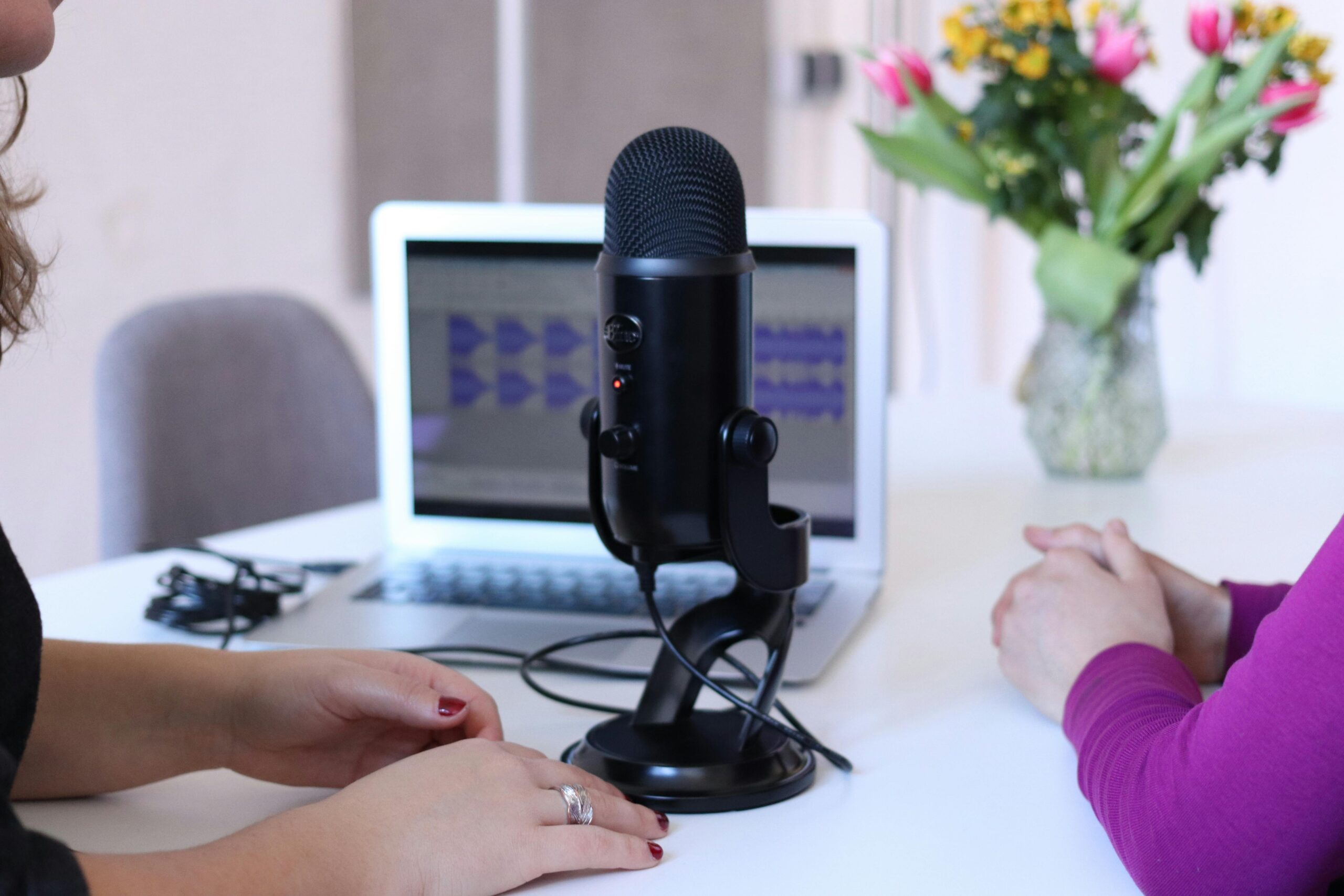Sharing knowledge, ideas, and tales with a worldwide audience has become increasingly common via podcasts. Starting a podcast can be profitable and fulfilling, given millions of people tune in daily. From planning to marketing, this article will guide you through the basic steps of creating a fantastic podcast.

Planning Your Podcast
Identify Your Place
The success of a podcast depends on selecting the appropriate place. Center on a subject you know a lot about and enjoy. This guarantees your motivation and ability to generate interesting work. Research popular subjects and audience preferences to find your specialty and distinguish it from the competition.
Define Your Audience
Knowing your target audience guides you in producing relevant material. Consider their listening tastes, age, and hobbies. Examining rival podcasts in your field of expertise might reveal what works. Match your material to your audience’s tastes and expectations.
Create a Podcast Blueprint
Arrange your podcast’s frequency, duration, and style. Choose whether it will be co hosted, solo, or based on interviews. Describe your episode’s framework with sections and transitions. Having a clear blueprint keeps listeners returning and helps to preserve consistency.
Preparing Your Content
Write Episode Scripts
Scripts prevent embarrassing pauses and enable you to stay on target. They should have important points and transitions even when they are not exact word for word. A well written script keeps listeners interested throughout the program and enhances the flow of your podcast.
Choose Catchy Episode Titles
Make it count as your episode title, which is what first impression viewers get. Call attention using interesting and vivid wording. Including pertinent keywords in your titles increases your podcast’s search engine and platform presence.
Plan Your Podcast Intro and Outro
A grand opening establishes the tone and introduces the subject of your podcast. Hook listeners with a little introduction and some appealing music. An interesting outro advances your social media platforms and motivates your fans. Consistent intros and outros help create brand recognition.
Gathering Your Equipment
Invest in a Quality Microphone
Podcast success depends on good audio quality, which cannot be negotiated. Verify the dependability of your microphone, it will assist in recording clear sound and reduce background noise. For beginning podcasters, USB microphones are cheaply priced and user friendly.
Get Software for Recording and Editing.
Use tools suitable for your degree of competence and financial situation. Although Adobe Audition presents advanced features, Audacity and GarageBand are free and simple applications. Editing helps your episodes look more professional and transparent; hence, it takes some time to master the chosen tool.
Organize Your Recording Area
Record from a quiet, comfortable space. Blankets or foam panels can help soundproof your space and cut echoes. A separate podcasting environment lets you maintain a consistent and neat recording style.
Notes on Recording Your First Episode
Plan a Test Run
Before shooting your first episode, work on familiarizing yourself with your tools and script. A test run gives assurance and flags up any flaws. Adjust your delivery and arrangement as needed to provide optimal sound quality.
Record with Confidence
Record with clarity and confidence. As you speak, smile; it naturally enhances your tone and vitality. Keep your script close by, but avoid sounding excessively polished. If your podcast shows honesty, it will be more relevant and fascinating.
Edit for Clarity
Editing removes lengthy pauses, background noise, and mistakes. Cut superfluous elements to make your software lean. Add music, sound effects, and voice enhancements to perfect and savor the finished work.
Organizing and Broadcasting Your Podcast
Choose a Podcast Hosting Platform
Podcast hosting sites gather your audio files and offer RSS feeds for distribution. Popular possibilities are Anchor, Pod bean, and Buzz sprout. Compare features and costs to choose the best fit for your needs.
Turn in to Podcast Directories
Sending your podcast to Google Podcasts, Apple, or Spotify increases your listener size. Use recognized submission guidelines and include an arresting cover and description. Using multiple platforms will scatter your audience.
Simplify Metadata for Search Engine Optimization
Your podcast title, description, and tags should all contain relevant keywords. This increases your podcast’s favorable search engine and directory discoverability. Obviously, keyword inclusion also increases user experience and search ranking.
Promoting Your Podcast
Apply Social Media
Post your episodes on sites including Facebook, Twitter, and Instagram. Share behind the scenes materials and teaser movies to generate buzz, including your listeners on social media, resulting in a passionate community around your podcast.
Work with Other Podcasters
Guest appearances and cross-promotion let you serve an audience more broadly. Collaborate with podcasters in like fields. Your podcast can introduce shoutouts and new listeners to cooperative episodes.
Motivational Reviews and Ratings
Good reviews and ratings help increase your podcast’s credibility and visibility. Tell viewers to leave comments at the end of every episode. Responding to reviews shows your regard for your audience’s perspectives.
Earning Money from Your Podcast
Sponsorships and Advertising
Work with companies to have sponsored messages in your episodes. Advertisements may run pre roll, mid roll, or post roll. Select advertisers who fit your audience to maintain listener confidence and interest.
Listener Support and Donations
Patron and other platforms enable your followers to support you financially. Provide members with unique content or incentives. The long-term viability of your podcast depends on a community eager to help you produce it.
Sell Merchandise
Design branded goods, like stickers, mugs, and T shirts. Talk about your store on social media and during episodes. Merch sales not only bring money but also improve the brand identification of your podcast to be stronger.
Monitoring and Improving Performance
Check Analytics
Track downloads, listener profiles, and episode popularity with analytics tools. Sites like Anchor and Pod bean offer an insightful analysis. Regular statistical review helps you identify the most relevant content for your audience.
Compile Comments from Readers
Get comments via social media, emails, or polls. Understanding your audience’s tastes or preferred changes will help you improve your work. Good comments will also help make your podcast more appealing and valuable.
Always Enhance Your Material
Keep open to changes and improvements. Test fresh segmentation or guest interviews. Keeping your material current and evolving guarantees an increase in audience and retention over time.
developing a strong brand identity
Design Eye Catching Cover Art
The first visual impression listeners see is your podcast cover image. Make it straightforward, unambiguous, and pertinent to the topic of your podcast. Even as a tiny thumbnail, use striking colors and understandable typefaces. Professionally appearing artwork may be made with help from applications like Canva and Adobe Spark.
Develop a Memorable Intro Musicto
A strong opening defines the tone and helps your podcast be immediately identifiable. Select royalty free music that suits the genre and tone of your podcast. Keep it brief about ten to fifteen seconds to maintain listeners’ interest without overpowering them.
Write a Consistent Branding Voice
The voice of branding for your podcast should reflect your particular style and specialization. Maintaining a continuous tone helps listeners relate, whether informal and humorous or professional and informative. Your voice should be engaging, confident, and open.
Invigorating Your Audience
Organize Q&A Calls
Plan concentrated Q&A sessions or include listener questions in your programming. This not only involves your audience but also fosters a feeling of community. Urge listeners to contribute questions by email or social media.
Create Listener Polls and Surveys
Get comments from your audience on guest or episode topics. Surveying social media sites like Twitter or Instagram increases engagement. Showing that you respect their points of view helps listeners to get connected and valued.
Respond to Comments and Messages
Spend some time replying to listener messages and comments on podcasts and social media a loyal fan base emerges from appreciating compliments and appreciation for listener support. Building rapport with your audience motivates long term participation.
Producing Excellent Content
Center on Narrative
Stories have material appeal and relevance. Whether sharing personal stories or interviewing visitors, be very aware of creating a narrative flow. Stories keep listeners emotionally engaged and help explain complicated concepts.
Provide Valuable Takeaways
People pay attention to picking knowledge or gaining understanding. Share doable ideas, wise advice, or provocative ideas. Stopping every episode with a quick review or key lesson adds value and helps to emphasize the key concepts.
Keep Episodes Targeted and Brief
Steer clear of long, winding episodes devoid of audience interest. Stay to your script and eliminate extraneous elements. Try to adopt a conversational tone and present content swiftly.
preserving consistency
Establish a Regular Upload Schedule
Consistency fosters loyalty and faith. Whether you run episodes every week or every month, use a calendar. Declaring your schedule upfront establishes expectations and keeps your audience engaged.
Batch Episodes of Record
Recording many episodes simultaneously saves time and guarantees a buffer for busy weeks. This method guarantees consistency even in the situation of unexpected interruptions. Use your editing sessions to finish several episodes effectively.
Stay Committed and Passionate
Success in podcasting requires time. Even if development is sluggish, stay committed and enthusiastic about your work. Remind yourself of your goals and purpose to remain consistent and motivated.
Improving Listener Retention
Use Teasers and Cliffhangers
Indicate the substance of the upcoming episode to build expectations. Cliffhangers and teasers invite viewers back. End of your episodes, previewing future subjects keeps your viewers interested and engaged.
Recap Previous Episodes
Starting with a quick review of past episodes helps new listeners catch up without feeling lost. Discussing past highlights also tells long time viewers of valuable content they might have overlooked or forgotten.
Build Themed Episodes and Series
Themed shows offer structure and keep viewers’ attention across numerous episodes. Whether it implies a multi part interview or a detailed investigation of a specific topic, series formats increase involvement and motivate viewers to keep going.
Conclusion
Starting a decent podcast requires regular labor, planning, and dedication. Well chosen material, specialty, and marketing strategy can translate your enthusiasm into business and a loyal following. Stay authentic, engage your audience, and never stop aiming for personal development. If you approach it right, your podcast may grow and affect the competitive scene for podcasting.
